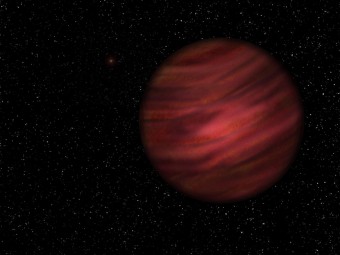-
30-01-2016, 07:32 #1
Ricordate il pianeta "vagante"? Par che orbiti anch'esso... lontano dalla sua stella
Questione molto interessante. Si può iniziare ad ipotizzare, o almeno sospettare, che anche gli altri pianeti apparentemente "vaganti, orfani unici di fu madre vedova", che immaginavamo soli e tristi con un cielo punteggiato solo di stelle e nebulose (avere anche un Newton da una manciata di pollici lassù...) se analizzati su scala sufficientemente grande e per un tempo sufficientemente lungo potrebbero in realtà rivelare di far parte di sistemi straordinariamente "diluiti" sul piano spaziale?
Lonely planet has a parent star after all
Once thought to be a free-floating planet, astronomers have now discovered it orbits its star only once every 900,000 years.
By Royal Astronomical Society, United Kingdom | Published: Tuesday, January 26, 2016
A team of astronomers in the UK, USA, and Australia have found a lonely planet, until now thought to be a free floating planet, in a huge orbit around its star. Incredibly, the object, designated as 2MASS J2126, is about 1 trillion (1 million million) kilometers from the star, or about 7,000 times the distance from the Earth to the Sun. The researchers report the discovery in Monthly Notices of the Royal Astronomical Society.
In the last five years a number of free floating planets have been found. These are gas giant worlds like Jupiter that lack the mass for the nuclear reactions that make stars shine, so they cool and fade over time. Measuring the temperatures of these objects is relatively straightforward, but it depends on both mass and age. This means astronomers need to find out how old they are before they can find out if they are lightweight enough to be planets or if they are heavier 'failed stars' known as brown dwarfs.
US-based researchers found 2MASS J2126 in an infrared sky survey, flagging it as a possibly young and hence low-mass object. In 2014, Canadian researchers identified 2MASS J2126 as a possible member of a 45 million-year-old group of stars and brown dwarfs known as the Tucana Horologium Association. This made it young and low enough in mass to be classified as a free-floating planet.
In the same region of the sky, TYC 9486-927-1 is a star that had been identified as being young, but not as a member of any known group of young stars. Until now no one had suggested that TYC 9486-927-1 and 2MASS J2126 were in some way linked.
Lead author Niall Deacon of the University of Hertfordshire has spent the last few years searching for young stars with companions in wide orbits. As part of the work, his team looked through lists of known young stars, brown dwarfs, and free-floating planets to see if any of them could be related. They found that TYC 9486-927-1 and 2MASS J2126 are moving through space together and are both about 104 light-years from the Sun, implying that they are associated.
"This is the widest planet system found so far and both the members of it have been known for eight years," said Deacon, "but nobody had made the link between the objects before. The planet is not quite as lonely as we first thought, but it's certainly in a very long distance relationship."
When they looked in more detail, the team were not able to confirm that TYC 9486-927-1 and 2MASS J2126 are members of any known group of young stars.
"Membership in a group of young stars is great for establishing an age," said study co-author Josh Schlieder of the NASA Ames Research Center, "but when we can't use that we need to resort to other methods."
The team then looked at the spectrum – the dispersed light – of the star to measure the strength of a feature caused by the element lithium. This is destroyed early on in a star's life so the more lithium it has, the younger it is. TYC 9486-927-1 has stronger signatures of lithium than a group of 45 million-year-old stars (the Tucana Horologium Association) but weaker signatures than a group of 10 million-year-old stars, implying an age between the two.
Based on this age the team was able to estimate the mass of 2MASS J2126, finding it to be between 11.6 to 15 times the mass of Jupiter. This placed it on the boundary between planets and brown dwarfs. It means that 2MASS J2126 has a similar mass, age, and temperature to one of the first planets directly imaged around another star, beta Pictoris b.
"Compared to beta Pictoris b, 2MASS J2126 is more than 700 times further away from its host star," Dr. Simon Murphy of the Australian National University, also a study co-author, "but how such a wide planetary system forms and survives remains an open question."
2MASS J2126 is around 7,000 Earth-Sun distances or 1 trillion kilometers away from its parent star, giving it the widest orbit of any planet found around another star. At such an enormous distance it takes roughly 900,000 years to complete one orbit, meaning it has completed less than fifty orbits over its lifetime. There is little prospect of any life on an exotic world like this, but any inhabitants would see their 'Sun' as no more than a bright star, and might not even imagine they were connected to it at all.
Fonte: http://www.astronomy.com/news/2016/0...NzI0MjgxNzE2S0INQUINAMENTO LUMINOSO - segnala impianti illegali nel territorio laziale, protetto dalla L.R. n. 23/2000: www.laziostellato.org
-
-
30-01-2016, 10:43 #2Staff • Moderatore Globale








- Data Registrazione
- Feb 2012
- Località
- Varese provincia
- Messaggi
- 6,663
- Taggato in
- 560 Post(s)



Re: Ricordate il pianeta "vagante"? Par che orbiti anch'esso... lontano dalla sua ste
Mettiamoci anche qualcosa in italiano....
Pianeta “orfano” ritrova la stella madre
Si chiama 2MASS J2126, orbita a settemila unità astronomiche dalla sua stella, TYC 9486-927-1, e un anno, lassù, dura circa 900 mila anni terrestri. La scoperta del legame gravitazionale che li unisce è descritta sull’ultimo numero di MNRAS
di Marco Malaspina
martedì 26 gennaio 2016 @ 15:37
Quanto distante dalla propria stella madre può un pianeta trascorrere l’esistenza pur continuando a far parte dello stesso “stato di famiglia”? L’attrazione gravitazionale, si sa, ha il guinzaglio lungo – basti pensare al potenziale Planet Nine ipotizzato giusto la settimana scorsa, che scorrazzerebbe in media a 700 unità astronomiche (oltre cento miliardi di km) dal Sole. Ma quello individuato dal team d’astronomi guidato da Niall Deacon della University of Hertfordshire ha infranto ogni record: si chiama 2MASS J2126, e a separarlo dalla stellina attorno alla quale danza, TYC 9486-927-1, c’è un abisso di circa mille miliardi di km.
Per farsi un’idea della distanza che li divide, basti pensare che il nostro pianeta solitario, per compiere una rivoluzione completa, impiega la bellezza di 900 mila anni! Partendo dal presupposto che si tratta d’un mondo assai giovane – il gruppo di stelle e nane brune nel quale si trova, noto come Tucana Horologium Association, si stima abbia suppergiù 45 milioni di anni – questo implica che un ipotetico abitante, residente lassù sin dalla genesi del pianeta, avrebbe vissuto a oggi non più di cinquanta primavere.
«È il sistema planetario più esteso mai scoperto finora. Conosciamo entrambi i suoi membri da otto anni», dice Deacon, riferendosi alla stella madre e al pianeta, «ma nessuno prima d’oggi aveva individuato un collegamento fra i due oggetti. Non è un pianeta solitario come pensavamo, dunque, ma quella che intrattengono è comunque una relazione a grande distanza».
In effetti 2MASS J2126 era ormai considerato un pianeta orfano, o vagabondo, come tanti ne circolano nel mezzo interstellare. C’è voluta tutta la pazienza osservativa del team d’astronomi inglesi, statunitensi e australiani per accorgersi non solo che stella e pianeta si trovano, rispetto a noi, alla stessa distanza (circa 104 anni luce), ma anche che si spostano insieme.
Per saperne di più:
- Leggi su Monthly Notices of the Royal Astronomical Society l’articolo “A nearby young M dwarf with a wide, possibly planetary-mass companion“, di N.R. Deacon, J.E. Schlieder e S.J. Murphy
Articolo originale QUI.
Collabora anche tu a creare ASTROWIKI! Unisciti al censimento utenti del Forum!!!
Reputazione: a cosa serve e perchè usarla con criterio
Etiam si omnes, ego non - Uno spirito forte, un cuore tenero - BLOG
-
30-01-2016, 11:14 #3
Re: Ricordate il pianeta "vagante"? Par che orbiti anch'esso... lontano dalla sua ste
A proposito di pianeti "vaganti", come disse QUI uno di voi, per rilevarli...
Due le strade praticabili.
O il microlensing,
o Chuck Norris con un binocoletto da teatro (ma buono però, tipo quelli russi)....Splende in un luogo oscuro...
-
30-01-2016, 11:17 #4
Re: Ricordate il pianeta "vagante"? Par che orbiti anch'esso... lontano dalla sua ste
Ahi ahi...a separarlo dalla stellina attorno alla quale danza c’è un abisso di circa mille miliardi di km.
E la mente umana vacilla di fronte a queste grandezze......Splende in un luogo oscuro...
-
30-01-2016, 13:36 #5
Re: Ricordate il pianeta "vagante"? Par che orbiti anch'esso... lontano dalla sua ste
interessante si,volevo chiedere una cosa:quando si parla di oggetti alla deriva,che si staccano dalla stella madre e "partono per la tangente" ,come funziona la dinamica? a meno di non ricevere una forza ed una velocità enorme che può addirittura in casi estremi farli uscire dalla galassia,essi prendono una traiettoria più larga?(esterna al centro galattico intendo)
-
30-01-2016, 14:17 #6
Re: Ricordate il pianeta "vagante"? Par che orbiti anch'esso... lontano dalla sua ste
INQUINAMENTO LUMINOSO - segnala impianti illegali nel territorio laziale, protetto dalla L.R. n. 23/2000: www.laziostellato.org
-
30-01-2016, 14:20 #7
Re: Ricordate il pianeta "vagante"? Par che orbiti anch'esso... lontano dalla sua ste
Ah ah ah sei un genio dell ironia!
 ...Splende in un luogo oscuro...
...Splende in un luogo oscuro...
-
30-01-2016, 16:05 #8
Re: Ricordate il pianeta "vagante"? Par che orbiti anch'esso... lontano dalla sua ste
Dipende molto dai casi, difficile valutare lo scenario iniziale perchè ci sono sempre problemi a multi-corpi in questo tipo di dinamiche. Diciamo che con molta probabilità deve essere accaduto o da un lato un evento significativo, come l'impatto di un corpo di grosse dimensioni, oppure dall'altro solo l'epilogo di un moto millenario che ha portato il pianeta ad indebolire il suo legame gravitazionale con la stella madre.
Altro scenario possibile ma ancora tutto da investigare nelle teorie di formazione planetaria è che esista di fatto una classe di pianeti che si può formare anche a grandi distanze dalla stella madre. Il problema di fondo è che può esserci al momento quello che chiamiamo un "bias di selezione", ovvero una sistematica mancanza di osservazioni di pianeti extrasolari confermati per il caso di grandi distanze dall'astro.
A causa della grande distanza infatti diminuiscono enormemente le probabilità che avvenga un transito davanti alla stella, e di conseguenza diminuisce anche la probabilità di trovare pianeti del genere. Questo appunto non implica che questi pianeti non siano duffisi, anzi potrebbero anche essere molto comuni in realtà, solo che al momento non lo sappiamo. Ci vorrebbero tecniche più avanzate, che prescindono dalla fotometria dei transiti, per arrivare a conclusioni di questo tipo.
-
30-01-2016, 19:54 #9
Re: Ricordate il pianeta "vagante"? Par che orbiti anch'esso... lontano dalla sua ste
Nel nostro piccolissimo, anche noi man mano che passa il tempo andiamo scoprendo corpi di dimensioni non troppo marginali sempre più orbitanti su traiettorie lontane, lontane, lontane dalla nostra stella madre.
Se tanto mi dà tanto, applicando il principio dell'attualismo di Lyell...INQUINAMENTO LUMINOSO - segnala impianti illegali nel territorio laziale, protetto dalla L.R. n. 23/2000: www.laziostellato.org
-
09-02-2016, 11:17 #10
-
Discussioni Simili
-
La favola del pianeta Buio e le nuove "news"
Di Vincenzo Zappalà nel forum NewsRisposte: 7Ultimo Messaggio: 05-09-2013, 19:56 -
"La vita su Marte se c'è è venuta dalla Terra". "No, al contrario da Marte a noi"
Di Valerio Ricciardi nel forum EsobiologiaRisposte: 1Ultimo Messaggio: 29-08-2013, 06:56 -
Un filmato in "stile" time lapse da Curiosity diffuso dalla NASA
Di Valerio Ricciardi nel forum Sistema SolareRisposte: 0Ultimo Messaggio: 03-08-2013, 12:09 -
La favola del piccolo pianeta "Bruno"
Di Vincenzo Zappalà nel forum ArticoliRisposte: 7Ultimo Messaggio: 03-12-2012, 16:44





 Rispondi Citando
Rispondi Citando




 )
)















Campo largo sulla Catena di...
Oggi, 09:30 in APOD by Astronomia.com